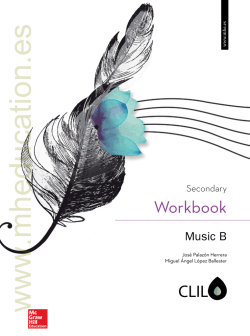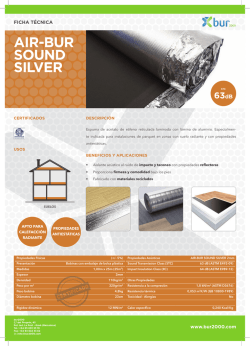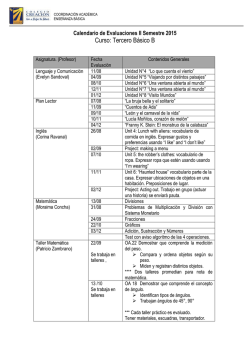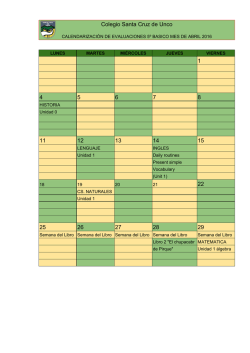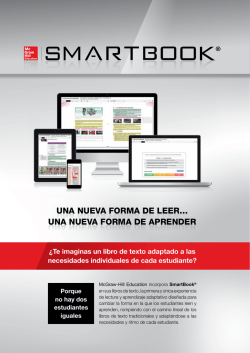
¡La tienda online de McGraw
www.mheducation.es www.mheducation.es MUSIC A SECONDARY Miguel Ángel López Ballester José Palazón Herrera José Luis Salas Martínez Raquel Cavas Hernández Workbook MADRID · BUENOS AIRES · CARACAS · GUATEMALA ·MEXICO · NEW YORK · PANAMÁ · SAN JUAN · BOGOTÁ · SÃO PAULO AUCKLAND · HAMBURG · LONDON · MILAN · MONTREAL · NEW DELHI · PARIS SAN FRANCISCO · SYDNEY · SINGAPORE · SAINT LOUIS · TOKYO · TORONTO www.mheducation.es CONTENTS UNIT 1 The Qualities of Sound 5 Mind map Unit activities Final activities Let's write music Let's read music Extension exercises Musical games Melody exercises Rhythm exercises 5 6 8 10 10 11 13 14 14 Mind map Unit activities Final activities Let's write music Let's read music Extension exercises Musical games Melody exercises Rhythm exercises 15 16 17 19 19 20 21 22 22 Mind map Unit activities Final activities Let's write music Let's read music Extension exercises Musical games Melody exercises Rhythm exercises 23 24 27 31 31 32 33 34 34 UNIT 2 Rhythm 15 UNIT 3 Melody and harmony 23 UNIT 4 Voice 35 Mind map Unit activities Final activities Let's write music Let's read music Extension exercises Musical games Melody exercises Rhythm exercises UNIT 5 Musical instruments 35 36 37 41 41 42 43 44 44 45 Mind map Unit activities Final activities Let's write music Let's read music Extension exercises Musical games Melody exercises Rhythm exercises 45 46 47 51 51 52 55 56 56 www.mheducation.es CONTENTS UNIT 6 Musical texture UNIT 7 Musical form UNIT 8 Popular urban music UNIT 9 Musical folklore 57 Mind map Unit activities Final activities Let's write music Let's read music Extension exercises Musical games Melody exercises Rhythm exercises 57 58 59 62 62 63 65 66 66 67 Mind map Unit activities Final activities Let's write music Let's read music Extension exercises Musical games Melody exercises Rhythm exercises 67 68 69 73 73 74 75 76 76 77 Mind map Unit activities Final activities Let's write music Let's read music Extension exercises Musical games Melody exercises Rhythm exercises 77 78 79 83 83 84 85 86 86 87 Mind map Unit activities Final activities Let's write music Let's read music Extension exercises Musical games Melody exercises Rhythm exercises 87 88 89 92 92 93 95 96 96 1 www.mheducation.es THE QUALITIES OF SOUND Sound The sensation we experience when the waves produced by the regular vibration of a sonorous object reach our ears. Noise Produced by the irregular vibration of a sonorous body. Silence Absence of sound or noise. Description: They are represented by: Pitch High / low Stave, clef and musical notation Duration Long / short Notes values and rests Dynamic Intensity Loud / soft Dynamics markings Timbre Who or what is emitting the sound Voices / instruments The qualities of sound Musical notation C D E F G A B C Note values and rests semibreve minim crotchet quaver semiquaver 4 2 1 1/2 1/4 Dynamics musical pp pianissimo (very soft) p piano (soft) mf mezzo-forte (medium) f forte (loud) ff fortissimo (very loud) crescendo diminuendo (increasingly loud) (increasingly soft) 5 www.mheducation.es UNIT 1 6 Unit activities This sections follows the numbering of the Student's Book. You will find discontinuous numbers, since only the exercises that the student must write have been included in this Workbook, whereas those which only involve listening or performing have been left out. This remark is valid for the rest of the Units. 1 2. Listen to the next track or «sound passage». Write down all the noises and musical sounds you can identify. Can you invent a story based on what you heard? 3. Write a description of all the sounds and noises you hear around you on a normal day. Do you think there is noise pollution in your surroundings? Use the table on the right to help you with your answer. WHO (World Health Organisation) says that the acceptable noise limit is an average of 65 dB per day. Finally, think about possible solutions to reduce the noise levels around us. 2 Birds singing 10 dB Leaves moving on the trees 20 dB Normal conversation 50 dB Traffic 85 dB Inside nightclubs 110 dB Motorbikes without silencers 115 dB A plane flying 130 dB 6. Listen to the following tracks and say which sound quality predominates over the others. a ) Autumn (1st movement): Vivaldi b ) Goyescas (intermezzo): Granados c ) Scheherazade: Rimsky Korsakov d ) The Young Person's Guide to the Orchestra: Britten www.mheducation.es THE QUALITIES OF SOUND Unit activities 3 7. Classify the pitch of the following sounds as low, medium or high. 1. 2. 3. 4. 5. 6. 7. 8. 8. Circle the lowest note in each pair of sounds. 9. Listen to the following sounds played by your teacher. Note the duration of each sound. Each box represents one beat. Example: Sound lasting 1 beat Sound lasting 2 beats 10. Translate the durations of the previous activity into note values. 4 13. Listen to the recording and identify how many changes of timbre occur. A Lot of Rhythm 7 2. Follow this diagram of 16 beats and mark the beats you hear in the exercise with an X. Before you begin, you will hear four introductory beats. 7 www.mheducation.es UNIT 1 5. 8 FINAL ACTIVITIES 3. Match the following qualities to their characteristics: Pitch • Duration • Dynamic intensity • Timbre • • Loud/soft • Long/short • Voice/instrument • High/low 4. Listen to the following sequence of sounds played by your teacher. For each sound, write down the qualities of sound you hear. All the qualities have a medium point. They can be high, medium or low; long, medium long or short; soft, medium loud or loud. Pitch Duration Intensity Sound 1 Sound 2 Sound 3 Sound 4 7. Click on the link to watch an animation about the effects of noise on the body: http://www.andaluciainvestiga.com/espanol/cienciaAnimada/sites/ruido/ ruido.swf. Use it to answer the following questions: a ) Current legislation sets a decibel limit for noise. Above this limit, noise has a harmful effect. What is the decibel limit? Name a noise above this limit. Now name a noise above the pain threshold. b ) Name three physiological effects that noise can have on people. www.mheducation.es THE QUALITIES OF SOUND FINAL ACTIVITIES 6. Complete the following sentences using words related to sound qualities: a ) The parameter or quality of time is the b ) A loud or soft sound is indicated by the c ) That voice sounds familiar, I recognise its d ) Her voice was so that I couldn’t hear her. e ) The siren made a very sound f ) The speakers were so ears rang for days. that my 7. Look at the score below and write the correct name below each note: 8. Observe the table. Write the name and duration next to each note value. Draw the symbols for the rests. Name Duration Rest Spanish American 9 www.mheducation.es UNIT 1 Let's write music 1. Draw treble clefs to the right of each of the ones shown here: 2. On the bottom stave, draw semibreve and crotchet heads on different lines and spaces of the stave. Try to draw the different notes so that the distances between each are the same. 3. Draw the missing stems on the notes. If you cannot remember the rules that apply to the drawing of stems, see the table below. How are the stems drawn on the notes? Above the 3rd line, stems are drawn to the left of the head, and downwards. Below the 3rd line, stems are drawn to the right of the head, and upwards. Since the note B is on the central axis of the stave, may be drawn either with the stem to the right and upwards or to the left and downwards. Let's read music 4. Mark a crotchet pulse and say the name of these notes without intoning them. Try to do it with a faster pulse each time. Exercise 1 Exercise 2 10 www.mheducation.es THE QUALITIES OF SOUND Extension exercises 5. Fill in the gaps. • Pitch distinguishes between sounds that are represented by . and It is • Duration is the aspect that distinguishes between sounds that are . It is represented by . • Intensity distinguishes between sounds that are cate this by . • Timbre is the parameter of sound that indicates and and We indi- makes the sound. 6. Order the following sounds based on their intensity, from greater to smaller: Leaves moving on the trees Birds singing Normal conversation Traffic Motorbikes without silencers Inside nightclubs 7. Complete the following table about the aspects of sound. Aspects Definition Representation high/low notes intensity 8. True (T) or false (F)? Pitch distinguishes between long and short sounds. Notes indicate the duration of the sound. Intensity distinguishes between low and high sounds. If you are playing a song with a recorder and then perform it with a guitar, the timbre changes. 11 www.mheducation.es UNIT 1 9. Represent the following sounds: a ) A low, long and loud sound. b ) A high, short and soft wound. a) b) 10. Link each of the following concepts with its corresponding aspect of sound: 12 Long / short • C• Trumpet • Low / high • Mezzo-forte • Semibreve • • Pitch • Dynamic intensity • Duration • Timbre Soprano • Loud / soft • 11. What is the difference between notes and written notes? Give an example of each. 12. Explain how you would indicate that a song... a ) ...is soft: b ) ...is very loud: c ) ...progressively decreases in volume: d ) ...progressively increases in volume: www.mheducation.es THE QUALITIES OF SOUND Musical games 13. Find in the wordsearch the name of six dynamic indications learnt in this Unit. pianissimo mezzo-forte fortissimo mezzo-piano piano forte crescendo diminuendo D T M H T A S V N O A P N C U Y Z C E D N D F P O O O M I S S I T R O F H M 4 H R L D I S I K K P M L N I U T Q E F W Y K I I A K Q N A H U L G K F D Z Z C N F U L N N P S G S L Q Z J O V Z F Y C N G E M F I I W A W R U B S W O D V V R N D B A A S A L N X A Z F C F P I V C E D I W P T S N F K V F O N O U W T I V S Z V Q M I I O X F Z X Y R D H S E Y N C N Q D Y L M M B J T M T N P T T L F Y E H M I C O O T S Q D E B W E R M O V P N A G P Q R P A V G P U U V O V V H U N D V K U H P R X U N R J Z F T A Q O A W O W A P B I K S T N U D Q O M K U D Y H O V F P O D N E U N I M I D D X Q R C H Y S O B C M J X K D S P S T T V L T D H F K N V N B C N H E W P M E Z Z O P I A N O M M M O J Y C T Z G U A M C L A C J L K E F Y B Y O O V D P P B R X K V A A P P C W S K S P G Q X G T X Q J R Q W P K U B 13 www.mheducation.es UNIT 1 Melody exercises Rhythm exercises 14 www.mheducation.es Publicaciones personalizadas a tu medida ¡Elige el contenido y crea el manual que mejor se adapta a tus necesidades! Create permite crear una obra personalizad a través de un proceso fácil e intuitivo seleccionando material del catálogo de McGraw-Hill. Además, se puede adaptar a las necesidades de cada docente ¡añadiendo material propio! El deseo de todos los profesores ha sido siempre tener el libro que refleje fielmente los temas del curso y con el que los alumnos dispongan de todo el material que necesitan para seguir la clase y superar la asignatura. McGraw-Hill Education fiel a su misión de ayudar a los docentes y enseñar a los estudiantes, pone a disposición de cualquier profesor su oferta editorial y la diversidad de las soluciones de aprendizaje de las que dispone para lograr este objetivo. Entra en nuestra web: http://create.mheducation.com ¡Accede a todo el catálogo! y crea tu libro a medida en 3 sencillos pasos www.mheducation.es McGraw-Hill Education Telf. Servicios al educador 902 289 888 / [email protected] www.mheducation.es IO PREMO SIM ACIÓN EDUC 2015 el ador d ® , gan n al Book Smart IMO Educació S Una nueva forma de leer... Una nueva forma de aprender ¿Te imaginas un libro de texto adaptado a las necesidades individuales de cada estudiante? Porque el aprendizaje lo cambia todo Premio ITAL SO DIG IAL ECUR R R O R IT O N ED MEJ EACIÓ ías DE CR nolog ad Tec d li a la d u o a . en la m sos para el r u c e yr SmartBook® es la primera y única experiencia de lectura y aprendizaje adaptativo diseñada para cambiar la forma en la que los estudiantes leen y aprenden, rompiendo con el camino lineal de los libros de texto tradicionales y adaptándose a las necesidades y al ritmo de cada estudiante. SmartBook® ¿Qué es? SmartBook® es una herramienta de aprendizaje adaptativo que combina una revolucionaria tecnología desarrollada por McGraw-Hill Education con un libro digital interactivo. SmartBook® analiza la forma en la que lee y aprende el estudiante y, en función de sus respuestas a preguntas sobre lo estudiado y la seguridad sobre sus conocimientos, le va guiando a través de los contenidos del libro, de una manera personalizada y adaptada a su propio ritmo de aprendizaje, para que cada minuto que pasa el alumno estudiando sea lo más efectivo posible. ¿Cómo funciona? SmartBook® consta de varias fases: Lee En la fase de lectura, el estudiante es guiado a través del texto para que lea de una manera adaptada a sus necesidades. En SmartBook® el estudiante tiene acceso al texto completo, pero se le mostrarán áreas resaltadas en amarillo que indican el contenido en el que debería centrar su estudio en ese momento concreto. Las áreas resaltadas del texto van variando en función de sus respuestas en la parte práctica, subrayando nuevos temas y conceptos de más nivel, una vez que el estudiante ha demostrado el dominio de los conceptos esenciales del tema. 2 Practica En la fase de práctica, los estudiantes afianzan lo aprendido hasta el momento realizando una serie de actividades de diversa tipología. Antes de responder, se pedirá al estudiante que evalúe el grado de seguridad sobre sus conocimientos: Sé la respuesta Eso creo No estoy seguro Ni idea En función de las respuestas a esas preguntas, el grado de seguridad que establezcan y otros datos que va recogiendo el sistema mientras los estudiantes trabajan, SmartBook® irá ajustando el camino de aprendizaje de cada estudiante adaptándolo a su ritmo y necesidades y determinando cuál será la siguiente pregunta. Lee Practica De vuelta en la fase Lee, el estudiante se encontrará con nuevas partes del texto resaltadas en amarillo, que indican el nuevo contenido a estudiar, y otras resaltadas en verde, que son los temas o conceptos que el estudiante ha demostrado que domina al responder correctamente a las preguntas en la fase de práctica. Subrayado amarillo: muestra el contenido que es importante para el estudiante en este momento. Subrayado verde: muestra el contenido que el estudiante ha demostrado que domina realizando preguntas en la fase de práctica. La mejor manera de estudiar con SmartBook® es ir pasando de una fase a otra hasta completar la unidad. La propia herramienta ayudará al estudiante a identificar cuándo ha llegado el momento de cambiar de fase. Repasa Para asegurar el dominio de los temas y la retención a largo plazo de los conceptos aprendidos, en esta fase el estudiante repasa en forma de actividades el contenido importante que el sistema ha identificado que es más probable que olvide. Informes Informes completos sobre el progreso del curso Profesor Los informes del profesor le permiten conocer en tiempo real las fortalezas y las debilidades de sus alumnos de manera individual y a nivel global, y adaptar así sus clases y tutorías. Estudiante Los informes del estudiante proporcionan detalles sobre su progreso, sobre los temas que domina y los que necesita estudiar más, para que pueda maximizar su tiempo de estudio. Beneficios Todo son ventajas Para el profesor: Para el estudiante: • Mejora la calidad y la productividad de las clases. • Ofrece el contenido adecuado para cada estudiante en el • Facilita la adaptación de las clases al nivel y necesidades de los alumnos. • Ayuda a prevenir el posible fracaso escolar y a remediarlo antes de que ocurra. • Mejora el rendimiento de los alumnos y su nivel de notas. momento preciso para maximizar el tiempo de estudio. • Excelente preparación para clase y para los exámenes. • Ayuda a retener conceptos clave a largo plazo. • Ayuda a conseguir mejores notas. • Herramienta online: sin descargas, sin necesidad de grabar el progreso. • Acceso en cualquier momento a través de una conexión a Internet y desde múltiples dispositivos. • Interfaz intuitiva y atractiva. • Es divertido, porque permite competir con otros usuarios. Integra SmartBook® en tu curso La mejor manera de sacar el máximo provecho a las ventajas de SmartBook® es crear una clase a la que se apuntarán tus alumnos. Los estudiantes pueden trabajar independientemente o asociados a tu clase, pero la experiencia es mucho más positiva y productiva si se integra SmartBook® como una parte más de la asignatura. Te damos algunas opciones o ideas: ... ... antes de ir a clase Puedes decir a tus alumnos que estudien con SmartBook® antes de ir a clase. Así, podrás basar tus clases en los datos que obtengas con la herramienta. ... como deberes Puedes presentar el contenido en clase y después, a modo de deberes, decirles que estudien el tema con SmartBook®. Posteriormente, en función de los datos que obtengas sobre el progreso, las fortalezas y las debilidades de tus alumnos, podrás reforzar ciertos contenidos y hacer un seguimiento general e individual de lo que realmente se ha aprendido. ... antes del examen Puedes dar la unidad completa y recomendar a tus alumnos que utilicen SmartBook® para preparar el examen. Si tienen examen de final de curso, recuerda a tus alumnos que utilicen regularmente la fase Repasa para estar preparados cuando llegue el gran día. Si tus alumnos tienen dificultades para acceder a Internet, una buena solución puede ser dedicar periódicamente tiempo de clase a SmartBook® en el aula de informática. www.mheducation.es McGraw-Hill Education una editorial global a tu servicio CICLOS FORMATIVOS FORMACIÓN PROFESIONAL CERTIFICADOS UNIVERSIDAD BACHILLERATO SECUNDARIA MEDICINA PRIMARIA PROFESIONAL Para más información: Tel. 902 289 888 [email protected] www.mheducation.es / www.mhe.es La tienda de McGraw-Hill Education te ofrece las mejores ventajas 5% de descuento Tus libros de texto con un Envío GRATIS en todo nuestro fondo editorial 20% de a partir de 25€ descuento Consigue tus Gastos de Envío GRATIS ¡Ahórrate un 20% en los libros de tus hijos cada curso! Ahora en McGraw-Hill Education te regalamos los gastos de envío. Si el importe de tu pedido es superior a 25€, los gastos de envío valorados en 5€ serán descontados de tu compra. Compra cualquiera de nuestros títulos para Primaria y ESO y disfruta de un descuento inmediato del 20% en el precio de tus libros. 5% de descuento en todo nuestro fondo editorial Todos los productos McGraw-Hill Education más económicos en nuestra tienda online. Selecciona tu producto y benefíciate de un 5% de descuento comprando cualquiera de nuestros títulos. Nuestro proceso de compra es muy sencillo 1 Localiza todos nuestros productos en el apartado TIENDA en el menú principal. 2 Encuentra tu producto navegando por nuestro catálogo o en el buscador. 3 Añade a la CESTA lo que quieres adquirir e inicia el proceso de compra, pinchando en REALIZAR PEDIDO. Regístrate como cliente y visualiza siempre que quieras el contenido de tu cesta o las compras realizadas ¡Todo el fondo de McGraw-Hill Education en papel o formato digital ahora más fácil y económico! www.mheducation.es Porque el aprendizaje lo cambia todo ¡La tienda online de McGraw-Hill Education! www.mheducation.es Toda la información | Todos los productos | Sencillo y rápido Atención al profesorado: 902 929 008 • 902 289 888 [email protected] McGraw-Hill Education Basauri, 17 - Edificio Valrealty - Planta 1ª 28023 Aravaca (Madrid) Teléfono: 91 180 30 00 • Fax: 91 180 31 00 www.mheducation.es
© Copyright 2025
